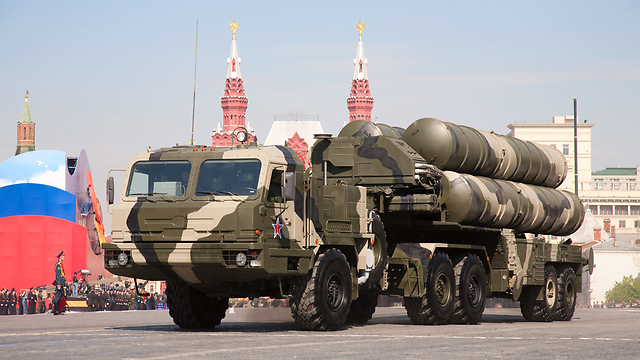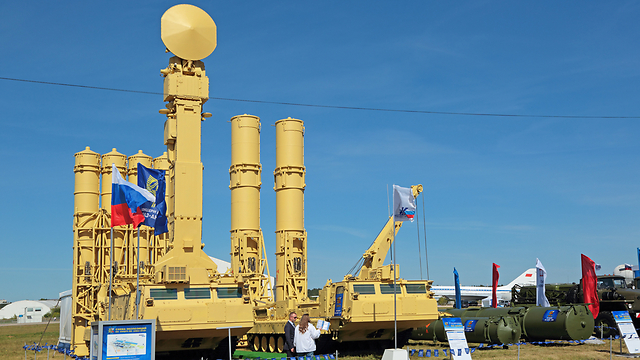
Russia prepares for US strike by deploying advanced missile defense system in Syria
As Putin and Obama duke it out over the Syrian conflict and standing plutonium disarmament agreement between their two countries, officials from both sides claim that Russia has been sending missile defense systems to Damascus; the supposed catalyst to the Kremlin’s latest move are statements made in Washington and London regarding the possibility of striking targets important to Russia and Syrian President Bashar al-Assad; as a close US ally and neighbor to war-torn Syria, Israel could very well be affected by these changing power dynamics.
US officials told Fox News on Tuesday evening that President Vladimir Putin has deployed SA-23 surface to air missiles in Syria. In addition, the Russian Defense Ministry issued a statement, saying that it has deployed an S-300 missile system to Syria. All this comes as Putin declared that he is freezing the plutonium agreement between the US and Russia, a move allegedly caused by the US freezing talks with the Russians on Syria, along with other "unfriendly actions."
The US officials claimed that these missile systems were put in place to ward off attacks by the US or its coalition members. The missile system, which can shoot anything down within a 150-mile radius, was set up at the Russian military base in Tartus, Syria. The missiles and their components are still in their crates and are not yet operational.
The US officials claimed that this is the first time SA-23 missiles are being deployed outside of Russia. The Russians sent the S-400 to Syria after one of their planes was shot down by Turkey.
The SA-23 can fire two different types of missiles. A smaller missile is used against aircraft and cruise missiles and is known by NATO as Gladiator. The larger missile is used against intermediate-range ballistic missiles and jamming aircraft and is known as Giant. Both missiles use the same type of warhead containing over 300 pounds of explosives, according to military-today.com.
While the purpose is not clear, one US official asked sarcastically, “Nusra doesn’t have an air force, do they?” speaking about the al-Qaeda-linked group in Syria. ISIS also does not fly any manned aircraft or possess cruise missiles. Therefore, the American officials see the deployment of the SA-23 to Syria as a sign that Russia is directing its actions to protect itself against any potential attack from the United States or its allies.
Russian actions reportedly reflect from a joint statement by officials in both London and Washington that the two countries are weighing "non-diplomatic ways and means" to stop the Russians and Syrians from bombing the eastern neighborhoods of Aleppo, which have not only become a rebel stronghold but are also home to approximately 350,000 Syrian civilians.

It is possible that the above statement was referring to military actions that seek to attain several goals, first among them being to neutralize and diminish the Syrian Air Force's battle readiness—primarily their helicopters, which continuously drop unguided barrel bombs on the civilian population.
Another likely goal is to stop Russian deliveries of bunker-busting missiles to the Aleppo area—missiles that have already killed dozens of civilians hiding in bomb shelters in the Aleppo area. This could be done by the US shooting ballistic missiles at Russian and Syrian air force bases or shooting Russian and Syrian aircraft themselves. By carrying out such an attack, the US would not be forced to get involved in direct fighting either on the ground or in the air.
The US could also use non-nuclear ballistic missiles for this purpose, or use cruise missiles that are already deployed on ships in the Sixth Fleet, which patrols the eastern Mediterranean Sea. The Russian air defense missiles are designed to defend against cruise missiles similar to what the US has in its arsenal.
The difference, however, between the S-400 anti-aircraft missile system that Russia deployed after one of their jets was shot down by Turkey last year and their SA-23 missiles, is that the SA-23 are designed for defense against low flying planes and missiles, as opposed to high flying ballistic missiles.

The presence of these two types of missiles on Syrian soil diminishes the deterrence factor against Syria and Hezbollah, and in a roundabout way— Iran. All of this at a time when no one knows if the Americans will begin ground operations in Syria.
The issue Israel has with these Russian air defense missiles in Syria is that Israeli planes flying in Israeli airspace or over the sea that are "returning fire" on targets in Syria or Lebanon may be shot down. The Russians may also choose to use these missiles against Israeli warplanes carrying out other operations in the region.
In an effort to move toward de-escalation, the UN Security Council discussed on Monday an immediate ceasefire proposal in Aleppo. Russia, for its part, declared that it had no intention to support the grounding of fighter jets.
Referring to moral accusations lobbied against his country, Russian Ambassador to the UN Vitaly Churkin additionally refuted claims that Russia was responsible for bombing hospitals and aid convoys, saying that Russia never intentionally strikes civilian targets, and that if it was not for Russia’s involvement in Syria, the ISIS flag would already have been raised in Damascus.












